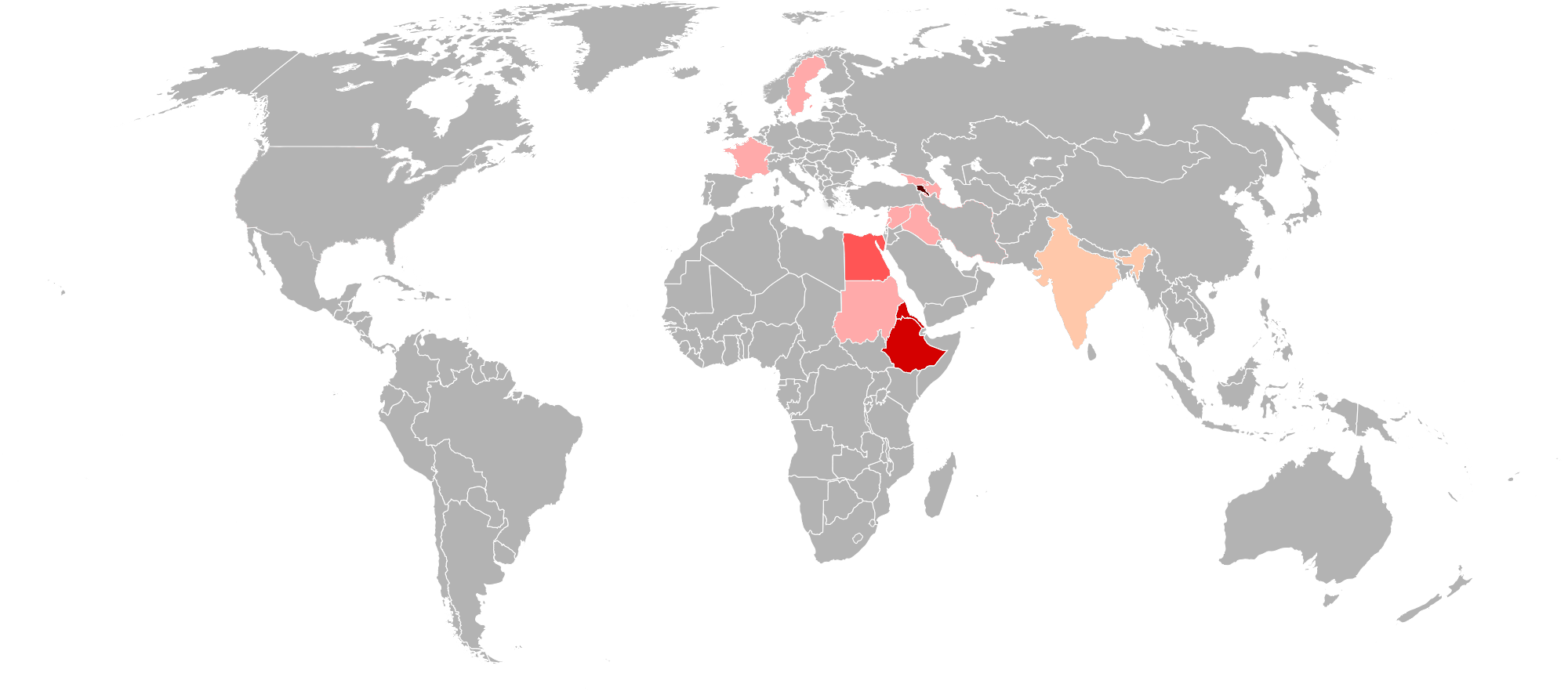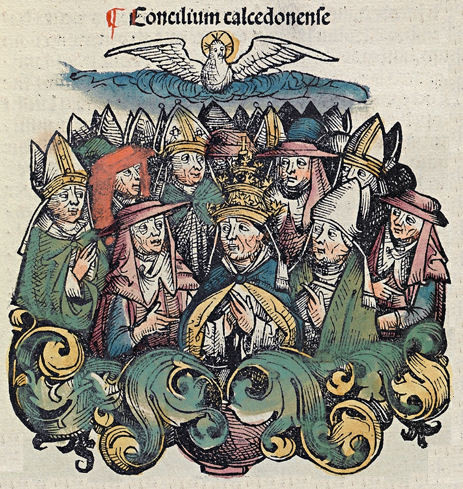|
Non-Chalcedonian
Non-Chalcedonian Christianity comprises the branches of Christianity that do not accept theological resolutions of the Council of Chalcedon, the Fourth Ecumenical Council, held in 451. Non-Chalcedonian denominations reject the Christological Definition of Chalcedon (which asserted Dyophysitism), for varying reasons. Non-Chalcedonian Christianity thus stands in contrast to Chalcedonian Christianity. Today, the Oriental Orthodox Churches predominantly comprise most of non-Chalcedonian Christianity. Overview The most substantial non-Chalcedonian tradition is known as Oriental Orthodoxy. Within this tradition are a number of ancient Christian churches including the Coptic Orthodox Church of Alexandria, the Syriac Orthodox Church (sometimes referred to as "Jacobite"), the Armenian Apostolic Church, the Ethiopian Orthodox Tewahedo Church, the Eritrean Orthodox Tewahedo Church and the Malankara Orthodox Syrian Church. The Christology of the Church of the East (i.e., Nestorian ... [...More Info...] [...Related Items...] OR: [Wikipedia] [Google] [Baidu] |
Patriarch Of Antioch
Patriarch of Antioch is a traditional title held by the bishop of Antioch (modern-day Antakya, Turkey). As the traditional "overseer" (ἐπίσκοπος, ''episkopos'', from which the word ''bishop'' is derived) of the first gentile Christian community, the position has been of prime importance in Pauline Christianity from its earliest period. This diocese is one of the few for which the names of its bishops from the apostolic beginnings have been preserved. Today five churches use the title of patriarch of Antioch: one Oriental Orthodox (the Syriac Orthodox Church); three Eastern Catholic (the Maronite, Syriac Catholic, and Melkite Greek Catholic Churches); and one Eastern Orthodox (the Greek Orthodox Church of Antioch). According to the pre-congregation church tradition, this ancient patriarchate was founded by the Apostle Saint Peter. The patriarchal succession was disputed at the time of the Meletian schism in 362 and again after the Council of Chalcedon in 451, whe ... [...More Info...] [...Related Items...] OR: [Wikipedia] [Google] [Baidu] |
Oriental Orthodoxy
The Oriental Orthodox Churches are Eastern Christian churches adhering to Miaphysite Christology, with approximately 60 million members worldwide. The Oriental Orthodox Churches are part of the Nicene Christian tradition, and represent one of its oldest branches. As some of the oldest religious institutions in the world, the Oriental Orthodox Churches have played a prominent role in the history and culture of Armenia, Egypt, Eritrea, Ethiopia, Sudan, Western Asia and India. As autocephalous churches, its bishops are equal by virtue of episcopal ordination. Its doctrines recognizes the validity of only the first three ecumenical councils. The Oriental Orthodox Churches are composed of six autocephalous churches: the Coptic Orthodox Church of Alexandria, the Syriac Orthodox Church of Antioch, the Armenian Apostolic Church, the Malankara Orthodox Syrian Church, the Ethiopian Orthodox Tewahedo Church, and the Eritrean Orthodox Tewahedo Church. They consider themselves t ... [...More Info...] [...Related Items...] OR: [Wikipedia] [Google] [Baidu] |
Oriental Orthodox Churches
The Oriental Orthodox Churches are Eastern Christian churches adhering to Miaphysite Christology, with approximately 60 million members worldwide. The Oriental Orthodox Churches are part of the Nicene Christian tradition, and represent one of its oldest branches. As some of the oldest religious institutions in the world, the Oriental Orthodox Churches have played a prominent role in the history and culture of Armenia, Egypt, Eritrea, Ethiopia, Sudan, Western Asia and India. As autocephalous churches, its bishops are equal by virtue of episcopal ordination. Its doctrines recognizes the validity of only the first three ecumenical councils. The Oriental Orthodox Churches are composed of six autocephalous churches: the Coptic Orthodox Church of Alexandria, the Syriac Orthodox Church of Antioch, the Armenian Apostolic Church, the Malankara Orthodox Syrian Church, the Ethiopian Orthodox Tewahedo Church, and the Eritrean Orthodox Tewahedo Church. They consider themsel ... [...More Info...] [...Related Items...] OR: [Wikipedia] [Google] [Baidu] |
Coptic Orthodox Church Of Alexandria
The Coptic Orthodox Church ( cop, Ϯⲉⲕ̀ⲕⲗⲏⲥⲓⲁ ⲛ̀ⲣⲉⲙⲛ̀ⲭⲏⲙⲓ ⲛ̀ⲟⲣⲑⲟⲇⲟⲝⲟⲥ, translit=Ti.eklyseya en.remenkimi en.orthodoxos, lit=the Egyptian Orthodox Church; ar, الكنيسة القبطية الأرثوذكسية, translit=al-Kanīsa al-Qibṭiyya al-ʾUrṯūḏuksiyya), also known as the Coptic Orthodox Patriarchate of Alexandria, is an Oriental Orthodox Christian church based in Egypt, servicing Africa and the Middle East. The head of the church and the See of Alexandria is the Pope of Alexandria on the Holy Apostolic See of Saint Mark, who also carries the title of Father of fathers, Shepherd of Shepherds, Ecumenical Judge and the thirteenth among the Apostles. The See of Alexandria is titular, and today, the Coptic Pope presides from Saint Mark's Coptic Orthodox Cathedral in the Abbassia District in Cairo. The church follows the Coptic Rite for its liturgy, prayer and devotional patrimony. The church has appr ... [...More Info...] [...Related Items...] OR: [Wikipedia] [Google] [Baidu] |
Chalcedonian Christianity
Chalcedonian Christianity is the branch of Christianity that accepts and upholds theological and ecclesiological resolutions of the Council of Chalcedon, the Fourth Ecumenical Council, held in 451. Chalcedonian Christianity accepts the Christological Definition of Chalcedon, a Christian doctrine concerning the union of two natures (divine and human) in one hypostasis of Jesus Christ, who is thus acknowledged as a single person ( prosopon). Chalcedonian Christianity also accepts the Chalcedonian confirmation of the Niceno-Constantinopolitan Creed, thus acknowledging the commitment of Chalcedonism to Nicene Christianity. In regard to their specific attitudes towards theological resolutions of the Council of Chalcedon, Christian denominations (both historical and modern) can be divided into: * Chalcedonian – those that accept theological resolutions of the Council of Chalcedon; * Semi-Chalcedonian – those whose acceptance of Chalcedonian theological resolutions is partial ... [...More Info...] [...Related Items...] OR: [Wikipedia] [Google] [Baidu] |
Church Of The East
The Church of the East ( syc, ܥܕܬܐ ܕܡܕܢܚܐ, ''ʿĒḏtā d-Maḏenḥā'') or the East Syriac Church, also called the Church of Seleucia-Ctesiphon, the Persian Church, the Assyrian Church, the Babylonian Church or the Nestorian Church, was an Eastern Christian church of the East Syriac Rite, based in Mesopotamia. It was one of three major branches of Eastern Christianity that arose from the Christological controversies of the 5th and 6th centuries, alongside the Oriental Orthodox Churches and the Chalcedonian Church. During the early modern period, a series of schisms gave rise to rival patriarchates, sometimes two, sometimes three. Since the latter half of the 20th century, three churches in Iraq claim the heritage of the Church of the East. Meanwhile, the East Syriac churches in India claim the heritage of the Church of the East in India. The Church of the East organized itself in 410 as the national church of the Sasanian Empire through the Council of Se ... [...More Info...] [...Related Items...] OR: [Wikipedia] [Google] [Baidu] |
Syriac Orthodox Church
, native_name_lang = syc , image = St_George_Syriac_orthodox_church_in_Damascus.jpg , imagewidth = 250 , alt = Cathedral of Saint George , caption = Cathedral of Saint George, Damascus, Syria , type = Church of Antioch, Antiochian , main_classification = Eastern Christianity, Eastern Christian , orientation = Oriental Orthodoxy, Oriental Orthodox , scripture = Peshitta , theology = Miaphysitism , polity = Episcopal polity, Episcopal , structure = Koinonia, Communion , leader_title = Patriarch , leader_name = Ignatius Aphrem II Syriac Orthodox Patriarch of Antioch and All the East, Patriarch , fellowships_type = Catholicos of India, Catholicate of India , fellowships = Malankara Syriac Orthodox Church , associations = World Council of Churches , area = Middle East, India, and Assyrian–Chaldean� ... [...More Info...] [...Related Items...] OR: [Wikipedia] [Google] [Baidu] |
Ethiopian Orthodox Tewahedo Church
The Ethiopian Orthodox Tewahedo Church ( am, የኢትዮጵያ ኦርቶዶክስ ተዋሕዶ ቤተ ክርስቲያን, ''Yäityop'ya ortodoks täwahedo bétäkrestyan'') is the largest of the Oriental Orthodox Churches. One of the few Christian churches in sub-Saharan Africa originating before European colonization of the continent, the Ethiopian Orthodox Tewahedo Church dates back to the acceptance of Christianity by the Kingdom of Aksum in 330, and has between 36 million and 49.8 million adherents in Ethiopia. It is a founding member of the World Council of Churches. The Ethiopian Orthodox Tewahedo Church is in communion with the other Oriental Orthodox churches (the Eritrean Orthodox Tewahedo Church, the Coptic Orthodox Church of Alexandria, the Malankara Orthodox Syrian Church, the Armenian Apostolic Church, and the Syriac Orthodox Church). The Ethiopian Orthodox Tewahedo Church had been administratively part of the Coptic Orthodox Church of Alexandria from the firs ... [...More Info...] [...Related Items...] OR: [Wikipedia] [Google] [Baidu] |
Armenian Apostolic Church
, native_name_lang = hy , icon = Armenian Apostolic Church logo.svg , icon_width = 100px , icon_alt = , image = Էջմիածնի_Մայր_Տաճար.jpg , imagewidth = 250px , alt = , caption = Etchmiadzin Cathedral, the mother church of the Armenian Apostolic Church , abbreviation = , type = , main_classification = Eastern Christian , orientation = Oriental Orthodox , scripture = Septuagint, New Testament, Armenian versions , theology = Miaphysitism , polity = Episcopal , governance = Mother See of Holy Etchmiadzin , structure = , leader_title = Head , leader_name = Catholicos of All Armenians Karekin II , leader_title1 = , leader_name1 = , leader_title2 = , leader_name2 = , leader_title3 = , leader_name3 = , associat ... [...More Info...] [...Related Items...] OR: [Wikipedia] [Google] [Baidu] |
Patriarch Of Alexandria
The Patriarch of Alexandria is the archbishop of Alexandria, Egypt. Historically, this office has included the designation "pope" (etymologically "Father", like "Abbot"). The Alexandrian episcopate was revered as one of the three major episcopal sees (along with Rome and Antioch) before Constantinople or Jerusalem were granted similar status (in 381 and 451, respectively). Alexandria was elevated to ''de facto'' archiepiscopal status by the Councils of Alexandria, and this status was ratified by Canon Six of the First Council of Nicaea, which stipulated that all the Egyptian episcopal provinces were subject to the metropolitan see of Alexandria In the sixth century, these five archbishops were formally granted the title of "patriarch" and were subsequently known as the Pentarchy. Due to several schisms within Christianity, the title of the Patriarch of Alexandria is currently claimed by different churches (two of which are part of the Catholic Church) and held respective ... [...More Info...] [...Related Items...] OR: [Wikipedia] [Google] [Baidu] |
Greek Orthodox Church Of Alexandria
The Greek Orthodox Patriarchate of Alexandria and all Africa ( grc, Πατριαρχεῖον Ἀλεξανδρείας καὶ πάσης Ἀφρικῆς, Patriarcheîon Alexandreías kaì pásēs Aphrikês, The Patriarchate of Alexandria and all Africa), also known as the Greek Orthodox Church of Alexandria, is an autocephalous patriarchate that is part of the Eastern Orthodox Church. Its seat is in Alexandria and it has canonical responsibility for the entire African continent. It is commonly called the Greek or Eastern Orthodox Patriarchate of Alexandria to distinguish it from the Coptic Orthodox Patriarchate of Alexandria, which is part of Oriental Orthodoxy. Members of the Greek Orthodox Patriarchate were once referred to as "Melkites" by non-Chalcedonian Christians because they remained in communion with the Ecumenical Patriarchate of Constantinople after the schism that followed the Council of Chalcedon in 451. Mark the Evangelist is considered the founder of the See, an ... [...More Info...] [...Related Items...] OR: [Wikipedia] [Google] [Baidu] |
Council Of Chalcedon
The Council of Chalcedon (; la, Concilium Chalcedonense), ''Synodos tēs Chalkēdonos'' was the fourth ecumenical council of the Christian Church. It was convoked by the Roman emperor Marcian. The council convened in the city of Chalcedon, Bithynia (modern-day Kadıköy, Istanbul, Turkey) from 8 October to 1 November 451 AD. The council was attended by over 520 bishops or their representatives, making it the largest and best-documented of the first seven ecumenical councils. The principal purpose of the council was to re-assert the teachings of the ecumenical Council of Ephesus against the heresies of Eutyches and Nestorius. Such heresies attempted to dismantle and separate Christ's divine nature from his humanity ( Nestorianism) and further, to limit Christ as solely divine in nature ( Monophysitism). Extended summary As recorded by American Christian scholar Jaroslav Pelikan, it was stated: Whilst this judgment marked a significant turning point in the Christolog ... [...More Info...] [...Related Items...] OR: [Wikipedia] [Google] [Baidu] |








.jpg)
